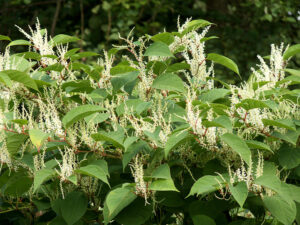Japanese Knotweed: Tips On How To Get Rid Of This “Godzilla” Weed That Is Threat To Your Plants

Identify The Japanese Knotweed
Before you pull out your pruning shears or weed killer (or call a landscaper), make sure that the invasive weed, is in fact, Japanese Knotweed. This type of weed is trickier when compared to other weeds, which means a Google search on “how to kill weeds invading my lawn” won’t be very helpful.
Japanese Knotweed is a perennial, which means it dies back over the winter months and returns when the weather starts to warm up. These plants prefer moist and sunny areas such as riverbanks, lawns, and gardens. They can reach up to 10 feet in length and the roots can penetrate up to 20 feet deep. The leaves are heart-shaped and typically larger than your hand, and they usually grow in clusters or clumps. The stems have “knots” every couple of inches, which is why they are called “knotweed”. The flowers of the Japanese Knotweed are cream-coloured and they bloom between 6 and 8 inches in height. The flowers also grow straight up.
Decide On Your Eradication Method According To The Time Of Year
The Japanese Knotweed grows aggressively, which means frequent yard work will be required. This usually includes shearing, pruning, and excavating to minimise or maintain the growth of the plant.
It is suggested that you use all the eradication methods that you can to maximise the success of removing Japanese Knotweed from your garden. If you are not sure about your ability or the time needed to tackle these invasive weeds, rather call in a professional. If you are needing Japanese knotweed removal, I do recommend hiring some japanese knotweed specialists for the job.
Smother The Japanese Knotweed In The Spring
Spring is the start of the Japanese Knotweed’s growth season. This is when you should use a tarp to smother the plants, keeping the tarp secured down using heavy rocks will typically kill these plants. To successfully smother Japanese Knotweed, cut the stems as close as you can to the ground. Remove any of the debris around the areas where the Knotweed is growing. Once the stems are cut down and the debris is cleared away, position your tarp over this area. Make sure the tarp overlaps to stop the edges of the stems from punching holes in the tarp which could let sunlight in. Japanese Knotweed thrives on rays of the sun, so keeping the sun out is one of your best ways to kill this invasive weed.
Hold the tarp down with cinder blocks, rocks, or any other heavy objects, so the tarp doesn’t move or blow away. New growth is common and may push your tarp up. You can deal with this issue by walking over these areas to trample any new growth. Since the plant won’t have any sunlight it usually won’t survive.
Leave your tarp where it is until a landscaping expert or you feel confident enough that the weed has died. Smothering is the best way to deal with Japanese Knotweed, but it is also the longest method, so you may want to add a few other methods to speed these processes up.
Cut Japanese Knotweed Down During The Summer
Surprisingly you can only suppress Japanese Knotweed and not eradicate it entirely when you cut these plants back. To completely eradicate the plant you need to use the other methods mentioned above.
Cut the stems of the plant as close to the ground as possible, which will stop it from photosynthesising in the summer sun. You must collect all the leaves and stems that you have cut, as these plants root easily and will start to grow again in the soil. Collect all the debris and watch the plant throughout the summer, so that you can pull out or cut any new growth that may emerge.
